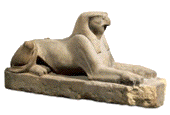
Examples:
The Great Sphinx, and Pyramids and Sphinx, photo from a postcard, c.1905.
Egypt, Sphinx of Senwosret III, c. 1878-41 BCE, Dynasty 12, reign of Senwosret III, Middle Kingdom, gneiss, length 28 3/4 inches (73 cm), Metropolitan Museum of Art, NY.

Egypt, Sphinx of Amenhotep III, c. 1391-53 BCE,
Dynasty 18, reign of Amenhotep III, New Kingdom, Egyptian faience, length
9 7/8 inches (25 cm), Metropolitan Museum of Art, NY.

Egypt, Abu Simbel, Hawk-Headed Sphinx, Dynasty 19, c. 1250 BCE, limestone, British Museum, London. A hawk-headed sphinx is sometimes called a gryphon. This one wears the lappet head-dress signifying the pharoah. See anthropomorphism.
Syria, Plaques: sphinxes, 8th century BCE, Syrian style, bronze, height 4.9 inches (12.4 cm), Metropolitan Museum of Art, NY.

Greece, Attica, Lekythos in the Form of Sphinx, late
5th century BCE,
clay, height
21.5 cm, State Hermitage Museum, St. Petersburg, Russia. The
well-preserved polychrome
painting on the sphinx
body makes this lekythos worthy of particular note: the blue
eyes shaded by their black eyelashes, the delicate color
of the cheeks, the pink lips and moderate use of gilding
enable us to imagine the original
color range of monumental
Greek sculpture of the Classical
epoch. See lekythos.

Greece, Attic, Grave stele of a youth and a little girl with
finial in the form of a sphinx, c. 530 BCE,
Archaic, marble,
height 13 feet 10 11/16
inches (423.4 cm), Metropolitan Museum of Art, NY. See finial
and stele.

Jean-Auguste-Dominique Ingres (French, 1780-1867), Oedipus Solves the Riddle of the Sphinx,
oil on canvas,
1808. See Neoclassicism.

Gustave Moreau (French, 1826-1898), Oedipus and the Sphinx, 1864, oil
on canvas, 81 1/4 x 41
1/4 inches (206.4 x 104.8 cm), Metropolitan Museum of Art, NY.
See Symbolism.
Boleslas Biegas (Polish, 1877-1954), 1902,
Sphinx, sculpture,
bust, Musée d'Orsay, Paris.
See Polish art and Symbolism.
Also see living rock.
https://inform.quest/_art